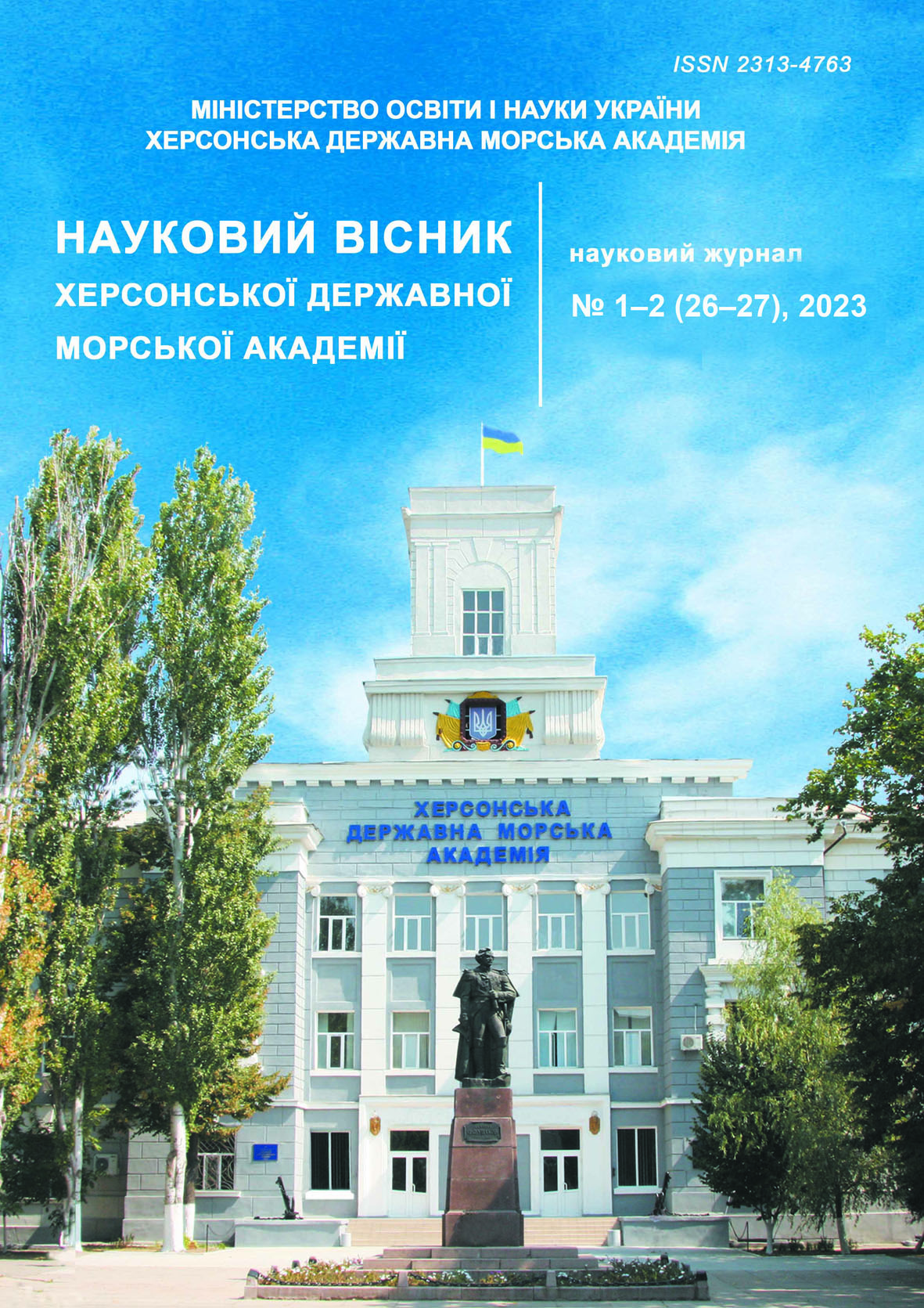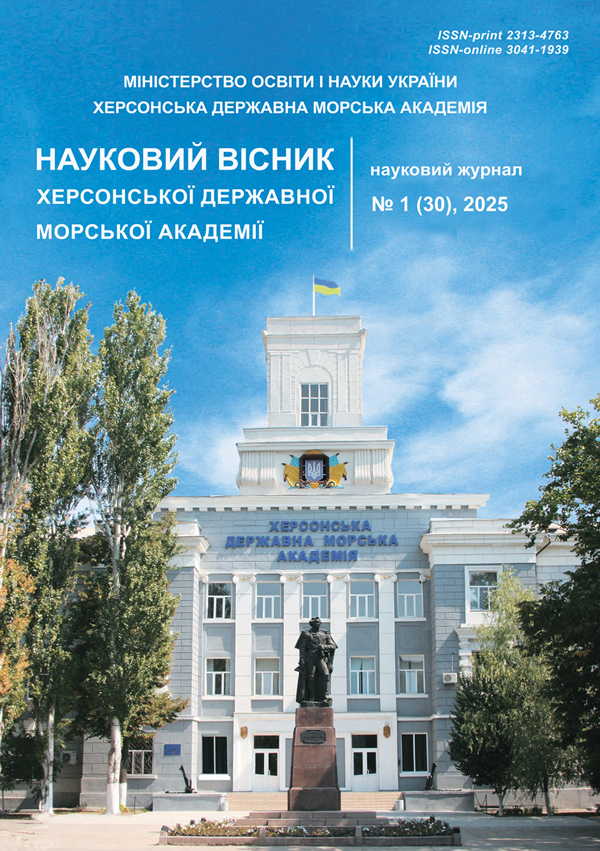АВТОМАТИЧНЕ НАЛАШТУВАННЯ НАДЛИШКОВОЇ СТРУКТУРИ СИСТЕМИ ДИНАМІЧНОГО ПОЗИЦІОНУВАННЯ ПО ДЕТЕРМІНАНТУ
https://doi.org/10.33815/2313-4763.2025.1.30.016-030
Анотація
Об'єктом дослідження є процеси динамічного позиціонування судна з двома кормовими азиподами і носовим підрулюючим пристроєм. Автоматизація процесів керування рухом дозволяє значно підвищити ефективність систем керування за рахунок використання сучасних методів обробки інформації, включаючи оптимізацію. Нові можливості підвищення ефективності систем керування з’явилися з використанням надлишкового керування. У морській галузі надлишкові структури найбільшого поширення набули у системах динамічного позиціонування. Однією із вимог до таких систем є забезпечення максимальної точності процесів позиціонування, у тому числі при дії зовнішніх впливів з будь-якого напрямку. На думку авторів, таку можливість системи керування можна забезпечити максимальним розведенням керуючих векторів структури (максимізацією детермінанту). У роботі розроблено метод налаштування надлишкової структури, який забезпечує таку можливість. Отриманий результат пояснюється: використанням у системі керування бортового обчислювача; знаходженням на кожному кроці бортового обчислювача оптимального стану структури, який визначається максимальним детермінантом, із врахуванням обмежень типу рівностей, для створення структурою необхідних керувань, та типу нерівностей, для врахування обмежень структури по максимальній силі упору і куту повороту гвинтів; переналаштуванням структури у визначене оптимальне положення. Працездатність та ефективність методу підтверджені математичним моделюванням у середовищі MATLAB.
Посилання
2. Zinchenko, S. N., Lyashenko, V. G., Shalaeva, A. A. (2017). Calculation and implementation of the maneuver of divergence from target vessels in the on-board digital computer, Matherials of the 4-st International Scientific and Practical Conference “Safety of life in transport and information technology, science, practice”, Kherson, 14–16 spring 2017, pp. 230–235.
3. Zinchenko, S. N., Lyashenko, V. G. (2017). Using a neural network model of a vessel to solve control problems, Scientific Bulletin of the KhDMA No. 2 (17), pp. 231–237. http://journals.ksma.ks.ua/nvksma/article/view/587/524.
4. Jacobellis, G., Gandhi, F., Floros, M. (2019). Using Control Redundancy for Power and Vibration Reduction on a Coaxial Rotor Helicopter at High Speeds, Journal of the american helicopter society. https://doi.org/10.4050/JAHS.64.032008.
5. Gao, W., Tang, Q., Yao, J., Yang, Y. (2020). Automatic motion planning for complex welding problems by considering angular redundancy, Robotics and Computer-Integrated Manufacturing, https://doi.org/10.1016/j.rcim.2019.101862.
6. Pakaste, R., Laukia, K., Wilhelmson, M., Kuuskoski, J. (1999) Experience with Azipod®propulsion systems on board marine vessels, Marine Propulsion. https://library. e.abb.com/public/2314773146eb2d77c1256ec300341511/12-18%20ENG%209902.pdf.
7. IMCA Marine Division: Guidelines for the design and operation of dynamically positioned vessels. (2019). The International Marine Contractors Association. https://www.imca-int.com/product/guidelines-for-the-design-and-operation-of-dynamically-positioned-vessels/.
8. Zinchenko, S., Kobets, V., Tovstokoryi, O., Nosov, P., Popovych I. (2023). Intelligent System Control of the Vessel Executive Devices Redundant Structure, CEUR Workshop Proceedings, Vol-3403, pp. 582–594. https://ceur-ws.org/Vol-3403/paper44.pdf.
9. Zinchenko, S. N., Lyashenko, V. G., Grosheva, O. A. (2018). Optimal control of redundant azipod structures, Proceedings of the V International Scientific and Practical Conference "Life Safety in Transport and Production: Education, Science, Practice", Kherson, September 13–15, 2018, pp. 78–81.
10. Cherniavskyi, V. V., Zinchenko, S. M., Nosov, P. S. (2021). The use of exsessive actuatos structures in automatic vessel movement control systems, Materials of the III International Maritime Scientific Conference of the ship power plants and technical operation department of odessa national maritime university (MPP&O-2021), Odessa, April 29–30, 2021, p.p. 466–472. https://doi.org/10.13140/RG.2.2.36574.15681.
11. Zinchenko, S. (2020). Study of a minimally excessive complanary control structute with two azimuth control devices, Materials of the VII International Scientific and Practical Conference "Life Safety in Transport and Production: Education, Science, Practice", Kherson, September 9–12, 2020, p. 319–325.
12. Zinchenko, S. M., Nosov, P. S., Mamenko, P. P., Moiseenko, V. S., Mateichuk, V. M., Kyrychenko, K. V., Polishchuk, V. O. (2021). Use of zero movements for adjustment of redundancy structures, Proceedings of the 1st International Scientific and Practical Conference "Problems of Sustainable Development of the Maritime Industry (PSDMI-2021), Kherson: KhDMA, November 3–4, 2021.
13. Santos, M. F., Santos Neto, A. F., Honorio, L., Silva, M. F., Mercorelli, P. (2023). Robust and Optimal Control Designed for Autonomous Surface Vessel Prototypes, IEEE Access, (99):1–1. https://doi.org/10.1109/ACCESS.2023.3239591.
14. Rigatos, G. A. (2022). Nonlinear optimal control approach for underactuated offshore cranes, Ships and Offshore Structures. https://doi.org/10.1080/17445302.2022.2150420.
15. Bao, X., Jiang, C. (2023). Time-Optimal Control Algorithm of Aircraft Maneuver, in book: Advances in Guidance, Navigation and Control. Proceedings of 2022 International Conference on Guidance, Navigation and Control. https://doi.org/10.1007/978-981-19-6613-2_454.
16. Bartels, S., Helling, S., Meurer, T. (2023). Inequality Constrained Optimal Control for Rope-Assisted ASV Docking Maneuvers, IFAC-PapersOnLine, pp. 44–49. https://doi.org/10.1016/j.ifacol.2022.10.407.
17. Leparoux, C., Herisse, B., Jean, F. (2022). Structure of optimal control for planetary landing with control and state constraints, ESAIM Control Optimisation and Calculus of Variations. https://doi.org/10.1051/cocv/2022065.
18. Cheng, X., Deng, S., Cheng, B., Meiqian, L., Zhou, R. (2020). Optimization of bias current coefficient in the fault-tolerance of active magnetic bearings based on the redundant structure parameters, Automatika, 602–613. https://doi.org/10.1080/00051144.2020.1806012.
19. Huang, W., Xu, H., Wang, J., Miao, C., Ren, Y., Wang, L. (2020). Redundancy Management for Fault-tolerant Control System of an Unmanned Underwater Vehicle, 5th International Conference on Automation, Control and Robotics Engineering (CACRE): Proceedings, China, 19–20 Sept. 2020. https://doi.org/10.1109/CACRE50138.2020.9230038.
20. Li, W., Shi, G. (2020). Redundancy management strategy for electro-hydraulic actuators based on intelligent algorithms. Advances in Mechanical Engineering. https://doi.org/10.1177/ 1687814020930455.
21. Piloting Vessels Fitted with Azimuthing Control Devices (ACD’s). (2013). United Kingdom Maritime Pilot’s Association (UKMPA), Transport House, London. https://www.yumpu.com/en/document/view/13677403/piloting-vessels-fitted-with-azimuthing-control-devices-acds.
22. Dakova, S., Wagner, J. L., Gienger, A., Tarín, C., Böhm, M., Sawodny, O. (2021). Reconfiguration Strategy for Fault-Tolerant Control of High-Rise Adaptive Structures, IEEE Robotics and Automation Letters, Vol. 6, Issue: 4, 2021. https://doi.org/10.1109/LRA.2021.3093861.
23. Gulay, T. A., Zakharov, V. V., Kron, R. V., Litvin, D. B., Popova, S. V. (2021). Mathematical model of reconfiguration of the aircraft integrated control system on the basis of embedding systems technology, AIP Conf. Proc., Vol. 2402, Issue 1, 070052. https://doi.org/10.1063/5.0074028.
24. Huang, R., Tang, S., Cai, Zh., Zhao, L. (2025). Robust Self-Reconfiguration for Fault-Tolerant Control of Modular Aerial Robot Systems, https://doi.org/10.48550/arXiv.2503.09376. https://arxiv.org/pdf/2503.09376.
25. Wen, J., Song, Ya., Wang, H., Han, D., Yang, Ch. (2023). Hybrid Adaptive Control for Tiltrotor Aircraft Flight Control Law Reconfiguration, Aerospace 10(12), 1001. https://doi.org/10.3390/aerospace10121001.
26. Hu, G., Li, Ya., Li, X., Zhang, G., Zhang, Zh., Wang, X., Man, W. (2023). Modular self-reconfigurable spacecraft: Development status, key technologies, and application prospect, Acta Astronautica, Vol. 207, P. 240–256, 2023. https://doi.org/10.1016/j.actaastro.2023.03.012.
27. Tan, J., Shang, M., Jin, L. (2024). Metaheuristic-Based RNN for Manipulability Optimization of Redundant Manipulators, IEEE Transactions on Industrial Informatics, Vol. 20, Issue 4, 6489–6498. https://doi.org/10.1109/TII.2023.3348830.
28. Liu, Y., Chen, X., Wu, L., Huang, G., Luo, J., Huang, Yu. (2024). Global optimization of functional redundancy in a 6R robot for smoothing five-axis milling operations, Engineering Optimization Vol. 56, Issue 1, pp. 138–154. https://doi.org/10.1080/0305215X.2022.2147519.
29. Gritsuk, I., Nosov, P., Bondarchuk, A., Bondarchuk, O. (2023). Using redundant control to optimize control torque, Technology audit and production reserves 3(2(71)):20–24, https://doi.org/10.15587/2706-5448.2023.282042.






